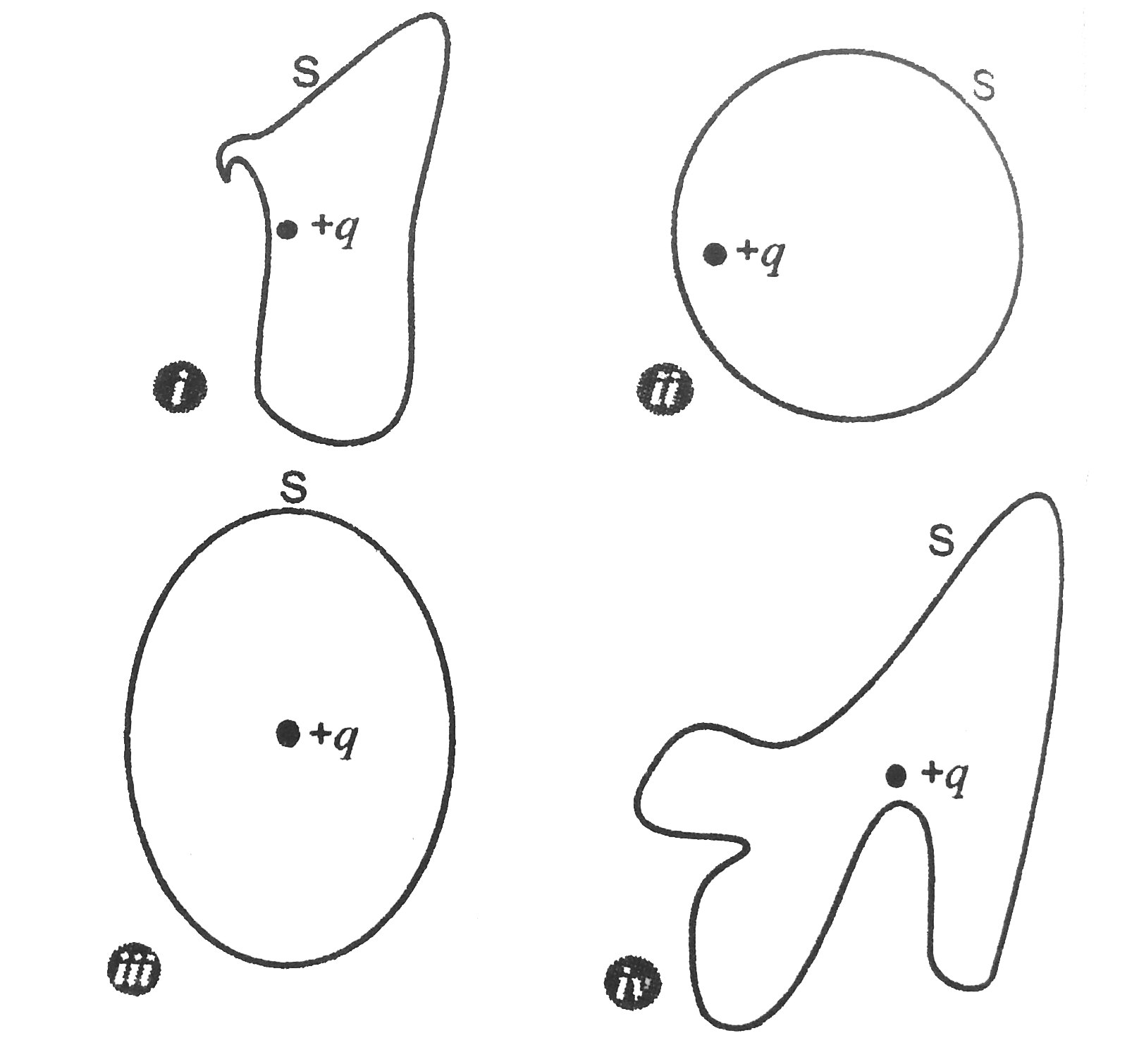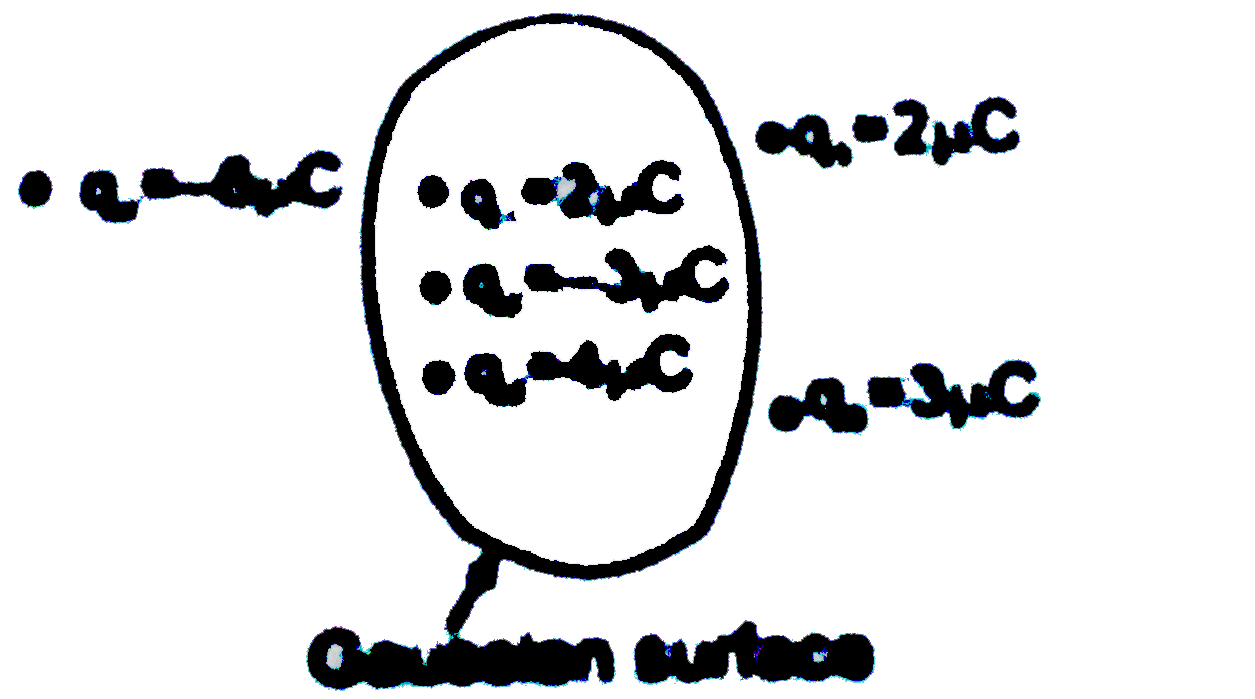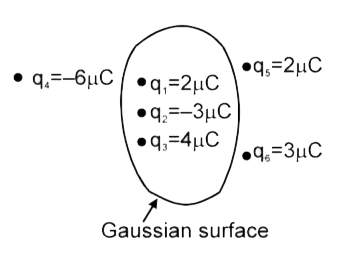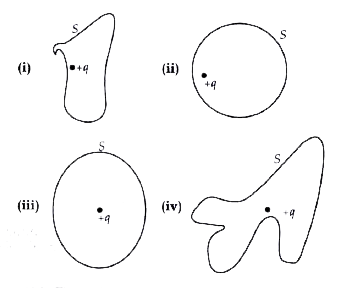Which of the following is true for electric-flux through a Gaussian surface ?
It depends on magnitude of charge enclosed by Gaussian surface
Electric flux is scalar quantity
Electric flux is independent of shape of Gaussian surface enclosing the charge
All are true
The correct Answer is:4
To determine which statements are true regarding electric flux through a Gaussian surface, we can analyze the properties of electric flux and Gauss's law step by step.
1. Understanding Gauss's Law:
Gauss's law states that the total electric flux (Φ) through a closed surface (Gaussian surface) is proportional to the net charge (Q_enclosed) enclosed within that surface. Mathematically, it is expressed as:
Φ=Qenclosedϵ0
where ε₀ is the permittivity of free space.
Hint: Recall that Gauss's law relates electric flux to the enclosed charge and is fundamental in electrostatics.
2. Dependence on Enclosed Charge:
From Gauss's law, we see that the electric flux through the Gaussian surface depends directly on the amount of charge enclosed. If the enclosed charge increases, the electric flux increases proportionally.
Hint: Consider how the electric field lines relate to the amount of charge; more charge means more field lines and thus more flux.
3. Nature of Electric Flux:
Electric flux is a scalar quantity. This is because it is derived from the dot product of the electric field vector and the area vector of the surface, which results in a scalar value.
Hint: Remember that scalar quantities have magnitude but no direction, unlike vector quantities.
4. Independence from Shape of Gaussian Surface:
The electric flux through a Gaussian surface is independent of the shape of that surface. As long as the charge enclosed remains the same, the flux will remain constant regardless of how the surface is shaped.
Hint: Think about how the same charge can be surrounded by different shapes (like a sphere, cube, etc.) but still produces the same amount of electric field lines passing through.
5. Conclusion:
Based on the above analysis:
- Statement 1: True (depends on the magnitude of charge enclosed)
- Statement 2: True (electric flux is a scalar quantity)
- Statement 3: True (electric flux is independent of the shape of the Gaussian surface)
- Statement 4: True (all previous statements are true)
Therefore, the correct answer is that all statements are true.
Final Answer: All are true (Option 4).
Gauss's law states that the total electric flux (Φ) through a closed surface (Gaussian surface) is proportional to the net charge (Q_enclosed) enclosed within that surface. Mathematically, it is expressed as:
Φ=Qenclosedϵ0
where ε₀ is the permittivity of free space.
From Gauss's law, we see that the electric flux through the Gaussian surface depends directly on the amount of charge enclosed. If the enclosed charge increases, the electric flux increases proportionally.
Electric flux is a scalar quantity. This is because it is derived from the dot product of the electric field vector and the area vector of the surface, which results in a scalar value.
The electric flux through a Gaussian surface is independent of the shape of that surface. As long as the charge enclosed remains the same, the flux will remain constant regardless of how the surface is shaped.
Based on the above analysis:
- Statement 1: True (depends on the magnitude of charge enclosed)
- Statement 2: True (electric flux is a scalar quantity)
- Statement 3: True (electric flux is independent of the shape of the Gaussian surface)
- Statement 4: True (all previous statements are true)
Topper's Solved these Questions
- ELECTRIC CHARGES AND FIELDS Book:AAKASH INSTITUTEChapter:ELECTRIC CHARGES AND FIELDS Exercise:SECTION-C ( OBJECECTIVE TYPE QUESTIONS)
Explore 1 Video
- ELECTRIC CHARGES AND FIELDS Book:AAKASH INSTITUTEChapter:ELECTRIC CHARGES AND FIELDS Exercise:SECTION-D(LINKED COMPREHENSION TYPE QUESTIONS) COMPHREHENSION-1
Explore 3 Videos
- ELECTRIC CHARGES AND FIELDS Book:AAKASH INSTITUTEChapter:ELECTRIC CHARGES AND FIELDS Exercise:ASSIGNMENT(SECTION-A) Objective Type Question
Explore 47 Videos
- DUAL NATURE OF RADIATION AND MATTER Book:AAKASH INSTITUTEChapter:DUAL NATURE OF RADIATION AND MATTER Exercise:ASSIGNMENT (SECTION-D)
Explore 10 Videos
- ELECTROMAGNETIC INDUCTIONBook:AAKASH INSTITUTEChapter:ELECTROMAGNETIC INDUCTIONExercise:ASSIGNMENT(SECTION -D) Assertion-Reason type Question)
Explore 15 Videos
Similar Questions
Knowledge Check
The electric flux through a closed Gaussian surface depends upon
Anet charge enclosed and permittivity of the medium.Bnet charge enclosed, permittivity of the medium and the size of the Gaussian surface.Cet charge enclosed only.Dpermittivity of the medium only.The electric flux through the surface
 Ain fig. (iv) is the largestBin fig. (iii) is the leastCin fig. (ii) is same as fig.(iii) but is smaller than fig.(iv)DIs the same for all the figures.
Ain fig. (iv) is the largestBin fig. (iii) is the leastCin fig. (ii) is same as fig.(iii) but is smaller than fig.(iv)DIs the same for all the figures.The electric flux through the surface
 Ain fig, (iv) is the largestBin fig, (iii) is the leastCin fig (ii) is same as a fig (iii) but is smaller than that in Fig (iv).Dis the same for all the figures.
Ain fig, (iv) is the largestBin fig, (iii) is the leastCin fig (ii) is same as a fig (iii) but is smaller than that in Fig (iv).Dis the same for all the figures.
Find out flux through the given Gaussian surface.

View SolutionIf the radius of the Gaussion surface enclosing a charge q is halved, how does the electric flux through the Gaussion surface change?
View SolutionIn the situatiioni when the Gaussian surface is so chosen that there are some charges inside and some outside, then regarding the electric field at any point and the electric flux through the Gaussaina surface, which of the following is correct?
View SolutionAn infinite, uniformly charged sheet with surface charge density σ cuts through a spherical Gaussian surfance of radius R at a distance X from its center, as shown in the figure. The electric flux Φ through the Gaussian surfce is .

View SolutionWhich of the following law gives a relation between the electric flux through any closed surface and the charge enclosed by the surface ?
View Solution


